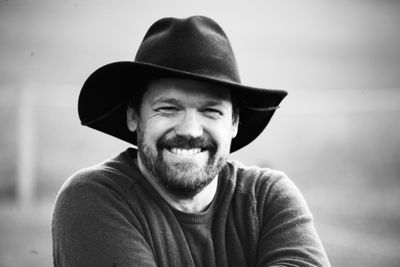I don’t know about you, but I get addicted to small, arty projects. I’ve noticed that, once I’ve conceived a vision of what something might become, if I were to do this, then that…I become a little obsessed, and have to apply quite a dose of discipline on myself to get back to my core work.
Recently I pulled out of storage an old flat wooden box, because it had some art supplies in it that I wanted. Instantly that I laid hands on the box, I realised that it could perform a new function that would be useful to me. But of course, if I was going to use it on a regular basis, I was no longer happy with its drab demeanor and limited functionality, so perhaps a lick of paint, and maybe some leather strap to hold things neatly within. But what sort of quick-access closures? And what sort of fixings to use on this thin timber? And so on, my mind lighting up and suddenly this new project is the most important task in my life right now.
Let’s juxtapose this little story of obsessive behaviour with the idea that our civilisation is mostly likely in a pattern of slow cascading break-down. And worse, the notion that our world is at risk of ecological collapse.
My behaviour in this context looks like something utterly forgettable, a slightly dysfunctional and irrelevant distraction. A waste of precious time, perhaps. It can certainly feel that way to me, like a pleasurable, guilty escape.
But I want to gently suggest that within moments and compulsions like this, that I know many of us have, is possibly a kernel of quintessential human behaviour that could, were it understood properly, carry us a long way.
What does it mean to have a design practice? I believe we all have one, in some form or another, because all humans have design capacity built into their brains, and it’s rare for any of us to not use it in some fashion.
This idea probably seems at odds with the usual notion of design as a professional specialisation, or discipline of study. But the usual notion is really just an over-emphasis on one end of a long continuum. People design things casually, on a daily basis, without a lot of thought or prior study. A kid's birthday party, a book of favourite recipes, a rostering system, perhaps.
Does this sound to you like the meaning of the word design is getting lost? Surely the word connotes a need for pre-planning and consideration of how underlying structure affects the resulting whole, in some important way that gives design it’s purpose and relevance? Isn’t that why the concept of design is applied to buildings and furniture and fashion and websites, and so forth—things that require complex thought in advance?
That’s somewhat true, but this too is, I think, a matter of degree. A recipe or a party also require some structural thinking and have complex intent behind them, it’s just that it’s not overly hard for us and so it happens quickly and without noticeable strain or duty of work. At this small-and-fast scale the process has some different characteristics, but it is still the same cognitive capacity in action.
My point is that people can regularly practice genuine design, either well or badly, without awareness of it, because our culture mostly reserves the word for those gaining status from it.
So far, not so challenging. We do also use the word quite casually, as in: ‘should we do a quick design sketch before making this quilt/dog kennel/hen house/spreadsheet?’
But what if I were to say that design thinking is also a highly shareable and developable meta-cognitive life-skill that we can all access for the good of our families, our communities and our place in the evolution of life on Earth?
This isn’t something that school or adult life, in my culture at least, teaches us to think.

What do I mean by meta-cognitive life skill? One entry into the meta-cognitive realm is to consider the way, for example, that we learn to learn. There are different ways and methods of learning, and humans who pay great attention to how learning happens can become highly proficient and effective at learning anything. You can become skilled at skilling—a powerful adaptive behaviour.
Another way of thinking about meta-cognition is to recognise that human acts of all kinds, but here I’m concerned with acts of creation, have a certain character of process, and that process is observable and malleable.
Design thinking is particularly powerful, as life-skills go, because design is so frequently needed, in the act of creating things of consequence. I’ll return to this later, but consequentiality is for us—for humans across time, I believe—one of the triggers of design process.
There can be, I’ve noticed, some confusion about whether design is essentially planning, in advance of making/building/creating, or built into the act of creation itself. Our answers to this affect our design practice quite profoundly. I believe that consequential design, at its best, is both these things, and how they relate to each other matters a lot. More on that in later posts.
Not all acts of creation need design. I don’t believe in trying to design a story or essay or novel, for example. It’s really best not to try to design a relationship. (But there is such a thing as relational design—which I’ll explore as soon as I’m able.) Most powerful art is given birth to, so to speak, rather than designed. And I strongly think, with deep respect to Daniel Christian Wahl, that cultures are not designed.1 Cultures evolve, from a great many points of consciousness, as emergent phenomena.
The need for design arises, I think, when we sense that a) something we intend to create is dependent on good structure, b) could have multiple different structures and c) that an optimal structure may or may not emerge in the raw act of creation.
Not that design is all about structure. In many ways its far more about the flow that good structure supports. But I do believe that within good design practice, structure cannot be ignored. And this goes for everything, not just those fields, like architecture and furniture design, where structural concern is clearly desirable. Design of organisations, governance and business models, experiences and events have the same characteristic, though less obvious in revealing what the underlying structure is made of, and where it lies.
This way of thinking about design, as a broad, ultra-flexible meta-cognitive human adaptation, opens up some lovely possibilities. It is possible, for example, to extend its nuanced power to virtually anything that we care about, within some natural boundaries, the limits of which are always—to me at least—shifting and tricky to see clearly. What we choose to extend it to is, of course, all about our values.
Within that proposed extension, one of the lovely sub-possibilities is that we can approach, with depth and granulated care, a redesign (and continual design-make-unfold) of our own lives. This, I've realised over time, is a wonderful thing. But as soon as I say this, I also feel a responsibility to speak urgently about a certain kind of caution.
A design practice is a fundamental human adaptive technology, both personal and social. It is fractally powerful, meaning that at a personal scale it might feel insignificant to the fate of the world, but in relationship, threading together throughout the social web and web of life, the way that people practice design is frighteningly significant. And this Western culture that you, my reader, likely inhabit, is somewhat out of control as regards to technologies, either physical or social.
For me and I know for many other ordinary humans, we are quite fine with a general principle of technological restraint. Know what you make. Know, as best you can, its implications. See its multi-sided potentiality. (To think more on this, perhaps read my earlier post, The Open Casket and the Dilemma of Homo faber.) And what’s more, don’t be greedy in reaching for its benefits. This is something of what I mean when I mentioned values.
But we can design our lives in a way that is both sophisticated and low-tech, given that the large majority of our needs can be met that way. Complementing this, we can also have a functional understanding of the high-tech sphere and be willing to enter it where we can safely embody its use in the service of life.
But we have to grapple, in this process, with our culture. Culture is the substrate upon which technology grows and has its effects on the world. But cultural influence is also fractal—it exists in the makeup of objects, artifacts and constructions; within each person, as a culture of mind; and across human groups and populations at larger scales; and at wider scales again, as a collective human consciousness.
Considering that any technology—the realm of techne—holds the potential for both harm to and enhancement of our lives, and the life around us, we have a responsibility to shore up and make beautiful the culture from which we design. We can do this personally, and socially, without forcing influence, by offering contributions to the ripple-out nature of each person’s actions in relation to the whole.

Thinking along these lines, then, it is also possible to design in a way that nicely unmoors and sets adrift the mechanistic thought-style taught to us by our culture, and becomes the same as the way life itself creates life. I say ‘the same’, rather than ‘like’, because while biomimicry is a great entry to better design thinking, there is no need to mimic life because we are a branch of life. We are as much an aspect of Gaia as anything else to which we might give the compliment of imitation. We can follow our own humanity, at the same time and as the same thing as following the ways of Gaia.
There is, emerging in the world as I write this, a design movement that is making this possibility real. The Regenesis Group2 is teaching thousands of people to think along these lines, and evolving the thinking as they go. The late Dan Palmer3 was working hard on opening this understanding, right up to his death in 2022. He, amongst others, was building on the life work of Christopher Alexander4, who also died in ‘22, leaving an astonishing legacy of insight. There are many more that I could mention, but you get the idea. People are finding their way home to this kind of practice.
My little project, the redesigned art box, can’t much claim this kind of design importance. In fact, it’s the lack of consequentiality that is part of its appeal. A rest from big-picture responsibility, away from social eyeballs. That and the way that even such a small project inevitably seems to develop earthly complexity as it goes.
All I wanted, I thought, was to hold certain art materials and equipment firmly in place, no matter how the box might slide off a car seat, or be otherwise jostled. And to have a certain visual and tactile (haptic) appeal, to take on a certain dignity of ritualised usefulness. Not so hard, just a few things to do.
But then, in the doing of it, it arises that the coats of paint and varnish need to wait for the fixings, so that their minor damage to the timber can be lacquered over; but the way I do the fixings is dependent on how the removable leather equipment rolls are made to fit, and how they arrange in space with each other; and it turns out the plan for that was predicated on the essential tool I have—pneumatic narrow-crown stapler, to be precise—which now I find out, as I worried over, has too much power for the thin timber shell, as well as the leather, causing me to rethink the entire approach. And so I adapt, and adapt, at every turn.
Meanwhile, I’m utterly absorbed. Despite my cursing, there is much joy. Most particularly in the way every adaptation and frustrated change of plan is making the end result better and better. I’m almost finished now, but it’s become something rather lovelier than I ever envisioned in the beginning. I would not know how to retrace my path.
Real-life design-creation, it seems, is like this. And it seems to me that the ability to hold many possibilities open at once, and allowing grace to arise out of real-world properties and relationships, even conflicts, beyond your control but in your hands, is somewhere near the heart of good design practice. The art box might be inconsequential, but I still experienced a fractal example of what its like with the big stuff.

I said that cultures evolve and are not designed, but acts of design can very much contribute to cultural evolution. Culture is at the heart of our ecological crisis, and culture change, culture-building, our most desperately needed project. Design is an essential, non-removable part of human cultures, and affects them greatly. Which is why we need to take responsibility for, and great care with, how we do it. Happily for us then, that the process is so damn joyful.
I for one would like to see a design renaissance emerge, in response to the nearness of collapse, a rich upswelling of newly sensitive design practice that aligns us culturally, accumulatively in snowball-style, with the stonkingly gorgeous processes of life itself.
If, as I began to suggest in the last post, ‘The life in our hands’, we can creatively re-design our home places, our livelihoods, and our community efforts, among other consequential things, then design thinking—learning to design well at any level—starts to smell distinctively like a form of cultural agency.
It is clearly not the only form, or the most important, but a form nonetheless, democratically accessible and profoundly human. And if it fails to help move the cultural needle the way we’d like, then at least the meta-cognitive depth and grace of design thinking will have empowered us in our own lives, and given us a way to take responsibility with our presence here on Earth, at this moment of human evolution.
I’m going back now, to tinker with my art box.
References:
1. Daniel Christian Wahl, Designing Regenerative Cultures, Triarchy Press, 2016. Note that Daniel acknowledges within the book that culture is not actually designed.
2. Regenesis Group. https://regenesisgroup.com/
3. Dan Palmer https://livingdesignprocess.org/
4. Christopher Alexander https://en.wikipedia.org/wiki/Christopher_Alexander
Images 1. Alan Scales / 2. Jonas Denil / 3. Eric Prouzet / 4. Marco Blazevic
Comments? If you would like to say something about this post, I'd love that. For personal reasons, I don't enable comments on the blog site, but please feel free to write to me—andy@wearehumans.com.au






